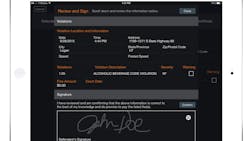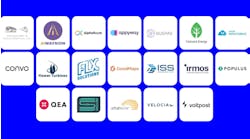Technology solutions driving enforcement to improve overall service
With instances of declining ridership and possible budget cuts, transit agencies are looking for ways to increase ridership by improving service efficiency while increasing revenue and implementing technology-driven solutions.
To create more efficient service, which in turn can boost ridership, more and more transit agencies are looking to bus-only lanes, especially in the instances of bus rapid transit routes. Dedicated bus lanes increase reliability by making it easier to navigate through traffic congestion but can fall short if there’s a lack of enforcement.
And turning to digitalization for processes such as fare enforcement can also increase efficiency because the technology can utilize less resources and less time.
Whether it’s bus-only lane or fare enforcement, streamlining the process can lighten the workload. And companies such as Siemens, EFORCE Software and Verra Mobility have taken notice and created technical solutions that can be implemented in a range of options.
Siemens provides scalable, autonomous technology for bus-only lane enforcement
Siemens offers its Civil Enforcement Solutions technology, which transit agencies are currently using to address issues interfering with road commuting services, such as cars in bus lanes or parking at bus stops, according to Marcus Welz, president of Siemens Intelligent Traffic Systems business for North America.
This scalable solution is autonomous and doesn’t require additional infrastructure or training.
“It just involves the installation of cameras on static fixtures, such as lamp posts or traffic lights or on moving buses, which was just recently done for the first time in New York City,” Welz said. “This is supported by a fully hosted solution for the back-end administration, which can be completely managed and maintained by a third-party.”
Implementing this solution can help with improved travel times, which in turn, can result in more consistent on-time performance, since the technology is able to capture offenders and help issue citations. Welz explains this solution allows transit agencies to man more bus stops without the sometimes-costly use of city or transit police forces, saying this solution “helps reduce the time and resources associated with manned enforcement of this type of behavior in the past.”
Most recently, this technology was implemented in New York City on the New York City Transit’s M15 Selected Bus Service route and is the first time this technology is beingit has been used on a city bus fleet. Welz says Siemens adapted existing technologies and utilized cameras tested for use in police cars and military vehicles while integrating real-time GPS data and video analytics.
“New York’s applications bring together several proven, mature technologies. For example, technologies like GPS, Automated License Plate Recognition and Geo-fencing often used in other scenarios but [are] now combined to help New York City better manage its problem of parked vehicles in bus zone,” Welz said.
Looking to the future, Welz says he expects this technology to generate interest from cities, specifically those looking to enforce their designated bus lanes.
“This is a very easy-to-install solution for cities – on either moving buses or static fixtures – that helps improve the journey time of city bus fleets through a fairly inexpensive and easy-to -maintain solution that can ultimately help change the behavior of bus lane and bus-zone violators – and hopefully increase confidence and ridership in our transit systems overall,” Welz concluded.
EFORCE simplifies fare enforcement with e-citation application
For transit agencies wanting to streamline the process of fare enforcement, such as the Denver Regional Transportation District (RTD), EFORCE has developed an e-citation application that can digitally capture information to issue warnings or citations, explains EFORCE Vice President of Sales and Marketing Ken Clark.
“Many people may not realize that our e-citation application for transit agencies actually came about because of a customer request,” Clark said. “At the time, RTD in Denver, Colo., was looking to streamline their fare enforcement process. Our original solution allowed RTD, and several customers who followed their lead, to digitally capture stopped rider information and issue warnings/citations.”
The application introduces a new process that reduces data entry and the time to issue a citation, improves accuracy and provides easier reporting tools, Clark explains. It operates with the hardware and sensors available on cellphones and tablets and has also been made available for more devices with the ability to interface with existing systems.
“Our e-citation application... provides plentiful data that can be used to improve everything from staffing to officer safety,” Clark said.
This technology also helps address the challenge of transit enforcement officials needing to be on the go and encountering focused stops.
“Our software continually uses geo-location to ensure officer safety and further uses this data when issuing citations,” Clark said. “With this data and external tools, agencies can create robust heatmaps of both officer location and infractions.”
Clark continued to explain that the integration of portable, wireless printers enables officers to quickly provide citations to customers, take pictures, look up driver license records and, with additional hardware, can scan fare cards.
In recent years, eFORCE has worked to enable the application for iOS and Android, with plans to release an application for Windows OS. Clark notes that while the application functions as a standalone software, it works best when integrated with RMS and CAD systems.
“It’s then that eFORCE becomes a full solutions provider for agencies by integrating valuable data such as contact history,” Clark added. “When properly deployed, e-citations will provide robust reporting, allowing agencies to optimize every facet of their organization.”
Verra Mobility introduces fixed and mobile solutions for bus lane enforcement
Verra Mobility has also been working on products to provide bus lane enforcement and currently offers two types of solutions that capture vehicles obstructing bus lanes whether they’re driving, illegally parking or stopping, explains Verra Mobility CEO David Roberts, saying the solutions vary from fixed, mobile or hybrid options.
“At the roadside we can capture data to quantify the magnitude of bus lane violations or install fully-operational enforcement programs capturing evidence of potential violations,” Roberts said.
The fixed is a mature solution and utilizes a pole-mounted camera on the roadside. The mobile option uses a bus-mounted camera to provide 100 percent route coverage in real time and is a newly released platform-as-a-service, Roberts says.
“[Capturing vehicle images] is accomplished with video analytics and Automated License Plate Recognition technology which allows it to determine if a vehicle has access to the bus lane based on its vehicle class [like a commercial bus or street sweeper],” Roberts said. “In addition to vehicle identification, the technology can also white list or blacklist specific vehicles by adding them to any agency list of license plate numbers [like police cars or ambulances].”
Both solutions include a back-office violation processing platform to create an end-to-end solution. The platform first uses a city’s rules to determine if a citation is needed and can then print, mail and process payments.
When it comes to keeping up with the changing needs of transit agencies, the solutions can be easily updated, such as adjusting the number of enforcement hours per day or modifying the enforcement rules programmed into the platform. And Verra Mobility is preparing for future needs as smart city practices gain popularity.
“Over time, we anticipate adding more smart and safe city technologies to the current solution,” Roberts said. “Eventually, it will be able to manage lane, pedestrian and micro-mobility enforcement, providing cities with more information, more data and more insights that can be leveraged to help traffic flow.”
Mitigating congestion and increased urbanization
For enforcement practices, technology solutions can be cost effective and time efficient. The scalability and range of options allows for agencies of any size to start implementing them. And as transit agencies look to increase ridership and mitigate more congestion, technology-driven solutions are a worthwhile investment.
“As congestion and commute times become more of an issue due to increased urbanization, cities are taking the lead and looking for technology solutions to help reduce commuting and emissions while improving pedestrian and creating mass transit efficiencies,” Roberts concluded.

Megan Perrero | Editor in Chief
Megan Perrero is a national award-winning B2B journalist and lover of all things transit. Currently, she is the Editor in Chief of Mass Transit magazine, where she develops and leads a multi-channel editorial strategy while reporting on the North American public transit industry.
Prior to her position with Mass Transit, Perrero was the senior communications and external relations specialist for the Shared-Use Mobility Center, where she was responsible for helping develop internal/external communications, plan the National Shared Mobility Summit and manage brand strategy and marketing campaigns.
Perrero serves as the board secretary for Latinos In Transit and is a member of the American Public Transportation Association Marketing and Communications Committee. She holds a bachelor’s degree in multimedia journalism with a concentration in magazine writing and a minor in public relations from Columbia College Chicago.


